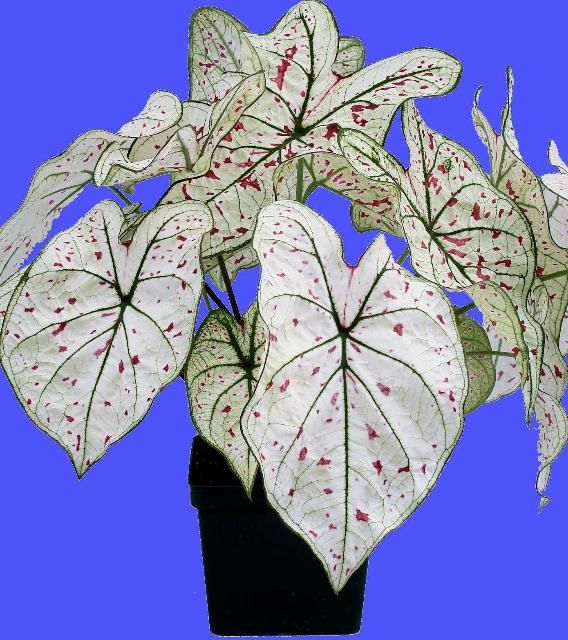'Cranberry Star' has a unique combination of leaf and tuber characteristics that make it ideal for use as a potted plant or for growing as an accent or border plant in shady landscapes (Deng et al. 2008). 'Cranberry Star' produces bright white leaves with green veins, similar to the leaves of 'Candidum', one of the most popular caladium varieties. However, 'Cranberry Star' is distinct in that it has numerous bright purple spots on its leaves.
Tubers of this variety are multi-branched, and de-eyeing may not be required even when forcing in small (4½ inch) containers. This trait can help growers save time and cost in preparing tubers for pot forcing. In field trials, 'Cranberry Star' produced more tubers and showed higher production values than 'Marie Moir' and 'Miss Muffet', two spotted commercial varieties. These characteristics should benefit growers as well as consumers who produce or use caladiums.
Origin
'Cranberry Star' was bred from a cross between a lance-leaved caladium selection, C35a, and a white, fancy-leaved (heart-shape) caladium seedling, UF-85245. Selection C35a and seedling UF-85245 were selected from the commercial variety 'Gingerland' and from a cross between 'Aaron' and 'Candidum Junior', respectively. The ancestry of 'Gingerland', 'Candidum Junior', and 'Aaron' is unknown.
Description
'Cranberry Star' leaves are heart-shaped and have green veins, white interveinal areas, and numerous purple spots (Figure 1). Plants grown in ground beds for four months in full sun had an average height of approximately 18 inches (Table 1). The largest leaves averaged up to 10 inches long and up to 6 inches wide (Table 2). Jumbo-sized tubers are multi-branched, bearing five to six dominant buds.

Credit: Zhanao Deng, UF/IFAS
Tuber Production
'Cranberry Star' was evaluated for tuber production at the UF/IFAS Gulf Coast Research and Education Center in Wimauma, FL, in 2005 and 2006. The soil was fine sand, containing approximately 1 percent organic matter, and the soil pH was less than 6.2. Seed tuber pieces were planted in plastic-mulched raised beds that were fumigated with a mixture of methyl bromide and chloropicrin (350 or 175 lb. per acre). Beds were 36 inches wide and 8 inches high. Planting spacing was 6 inches between rows and within row. Irrigation was through a seepage system. Controlled-release fertilizer (Osmocote 18-6-12, eight to nine months) was applied at the rate of 300 lb. nitrogen per acre when plants began to emerge.
Tubers were dug in November to December each year, dried in the greenhouse for three weeks, and graded by size, as follows: No. 2 (1–1½ inches), No. 1 (1½–2½ inches), Jumbo (2½–3½ inches), Mammoth (3½–4½ inches), and Super Mammoth (>4½ inches). The production index per planting plot was calculated as follows: number of No.2 tubers x 1 + number of No. 1 tubers x 2 + number of Jumbo tubers x 4 + number of Mammoth tubers x 6 + number of Super Mammoth tubers x 8. Thirty seed tuber pieces were planted in a planting plot covering 13.5 square feet.
'Cranberry Star' produced 74 and 45 marketable tubers (No. 2 or larger tubers) per plot in 2005 and 2006, respectively, which is 61–100 percent more tubers than 'Marie Moir', 'Miss Muffet', and 'Candidum' in 2005 and 15–50 percent more in 2006 (Table 3). 'Cranberry Star' had a good distribution of tubers with approximately 90 percent in the No. 1, Jumbo, and Mammoth categories, similar to that of 'Candidum' and 'Miss Muffet'. The production index for 'Cranberry Star' was 42–97 percent greater than that of 'Marie Moir', 'Miss Muffet', and 'Candidum' in 2005 and 41–178 percent greater than these cultivars in 2006.
Container Forcing
The suitability of 'Cranberry Star' for container forcing was evaluated by forcing tubers in 4½-inch containers. Tubers were either intact or de-eyed, and one No. 1 tuber was planted in each pot filled with VerGro Container Mix A (Verlite, Tampa, FL). Plants were grown in a greenhouse with 50 percent light exclusion. 'Cranberry Star' tubers sprouted in 31–33 days after planting, four to nine days earlier than 'Marie Moir', similar to 'Candidum Junior', and approximately four days later than 'Miss Muffet'.
On average, 'Cranberry Star' plants were 8–10 inches tall, similar to 'Marie Moir' and 'Candidum Junior', but taller than 'Miss Muffet', a known dwarf variety (Table 2). 'Cranberry Star' leaf size was similar to or slightly larger than 'Candidum Junior', but smaller than 'Marie Moir' and larger than 'Miss Muffet'. 'Cranberry Star' produced high quality pot plants in 4½-inch pots even without de-eyeing. When tubers were de-eyed, 'Cranberry Star' produced 60–80 percent more leaves than 'Marie Moir', 'Candidum Junior', and 'Miss Muffet', resulting in higher quality ratings on its pot plants.
Landscape Performance
The overall plant performance was rated on a scale of 1–5: 1 = very poor (few leaves and lack of vigor), and 5 = excellent (full plants, numerous leaves, and bright color display). 'Cranberry Star' had a rating of 4 when evaluated three months after planting, higher than 'Morie Moir', 'Miss Muffet', and 'Candidum', and a rating of 4.6 at the four-month evaluation, also higher than the three commercial varieties (Table 1).
Summary
'Cranberry Star' is intended for use in containers and shady landscapes. Its performance was outstanding, both in pots and landscapes, and superior to 'Marie Moir', a variety that has a leaf color and coloration pattern similar to 'Cranberry Star'. 'Cranberry Star' also out-performed 'Candidum' and 'Miss Muffet', two popular commercial varieties considered profitable to grow by the tuber-producing industry and also valued in the pot and landscape industries.
Availability
A plant patent (PP20,792) has been issued for this cultivar by the US Patent and Trademark Office,and plant patent rights have been assigned to the Florida Foundation Seed Producers, Inc. Propagation and distribution will be licensed by the Florida Foundation Seed Producers, Inc., PO Box 110200, Gainesville, FL 32611. Information on tuber availability and propagation agreements can be obtained from the Florida Foundation Seed Producers, Inc.
Reference Cited
Deng, Z., B.K. Harbaugh, and N.A. Peres. 2008. "'Cranberry Star' - A fancy-leaved caladium for containers and shady landscapes." HortScience 43(1): 252-254.
Tables
Plant performance four months from planting 1-inch tuber propagules in ground beds in full sun in 2005 and 2006. Values presented are average of three replications with three plants measured per plot (i.e. three subsamples) per year, except for the overall plant performance rating, which was taken in 2005.
Plant performance for caladium varieties grown from No. 1 tubers in 4½-inch containers in a 50 percent shaded glasshouse, 2007, Wimauma, FL. Values represent the means of 10 plants produced from intact or de-eyed No. 1 (>1½ and <2½ in diameter) tubers planted individually per container.

